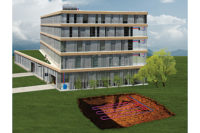
How much money do you save? At least 35-50% per month, depending on the season. In summer, the savings are greater because the water is used in many ways. Some Web sites that have economic calculators where HVAC systems and components can be compared are: Bae.uky.edu, CheResources.com, EnergyCodes.gov, EnergyStar.gov, GreenBiz.com, and WaterFurnace.com
The HVAC system size and type are designed and selected to the owners' needs in the traditional effort. The geothermal portion replaces the condenser unit and/or boiler. The system in my home is a retrofit design for a 2,200-sq.-ft. house on two acres in a suburban New Jersey neighborhood. The two-story house was built in 1993 with vinyl siding, double pane windows and of average construction. Five years ago, an additional 900 sq. ft. of the below-grade basement was finished into a playroom. Our geothermal system replaces the outside condenser unit and Freon coil. It also provides an additional method for heating because the original forced hot air furnace will continue to serve the first and second floors on the coldest days of December, January and February.
The cooling load for my house is calculated at seven and a half tons cooling and 110,000 Btus/hr heating; however, the playroom always feels too cold. Considering the number of peak heating and cooling degree-days, and that heat pump unit is only available in 240 volts up to six tons, I purchased a six-ton unit to accommodate my family's needs without comprising comfort.
The heat pump unit chills the water to 45 degrees to air condition the house. The well water removes the heat created by the heat pump in the refrigeration process; this byproduct leaves the unit hot around 80 degrees. This hot water is used to preheat the water entering the domestic water heater. The byproduct water can also be used to heat a basement, pool, towel warmers, or to preheat a hot tub. The cooler water leaves the house around 70 degrees to a pre-cast concrete tank buried three feet underground (an acclamation tank, to acclimate the water temperature back down near ground temperature). The byproduct water mixes with water in the tank and acclimates back down to the ground temperature of 60 degrees.
The well was drilled eight years ago for irrigation of the vegetable garden, flower garden, landscape shrubs and lawn. The water table varies between 60 to 80 feet with the aquifer at 100 feet. A pump from the well pumps water from 150 feet deep within the ground at a temperature of 58/50 degrees peak summer/winter. This water is sent to a reservoir tank in the basement of the home. The well pump works independently of the HVAC equipment to maintain the water quantity in the reservoir tank.
How much irrigation water will be generated?
I computer-selected our heat pump conditions to operate at 7 gpm in summer and winter. This allows the balance valves on the heat pump to be set once as in a typical installation. In the summer I can increase the water flow to 10 gpm and achieve a higher efficiency. For the three months of winter, the basement playroom heating load is only 18,000 Btuh, so the additional capacity is used to preheat a hot tub.The heating & cooling degree days for Princeton, NJ, are 5400/840 respectively. With our thermostat-1 set at 78/85 cooling occupied/unoccupied and 72/65 heating occupied/unoccupied, I will pump 9,450/5880 gallons of water. The system should require 250-800 gallons per day. As spring turns to summer, the more water that is needed coincides with the air conditioning demand. Similarly, as summer turns to fall, the demand reduces.
Consider other buildings without a water utility connection. A large building could require a 10,000-gallon underground water storage tank for fire protection. That tank could act as the temperature acclamation tank to additional in-line tanks for local irrigation. A golf course clubhouse can send the water to a pond for irrigation of the playing greens. A farm can use the water for wash down of livestock or irrigation, and a cabin as flushing water or a trout pond. All of these could be done on an estate.
In the early morning, the water from the acclamation tank is pumped via submersible pump to water the lawn and gardens. The sprinkler system operates independent zones on timers in the usual manner. If water is not required for irrigation, or in the winter, the water flows freely back to the top of the well. If the tank runs low of water, a float switch on the pump protects the pump from running dry, which would cause the motor to burn out. My largest zone, the front yard, has nine sprinkler heads that use 5 gpm. At the peak of summer, the zone operates for 20 minutes every other day. 900 gallons is just enough to almost deplete the acclamation tank. The remaining zones are timed for the water usage, about 250 gallons per day.

